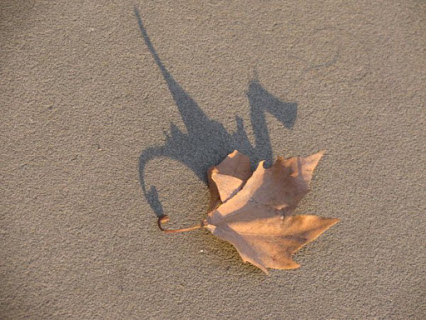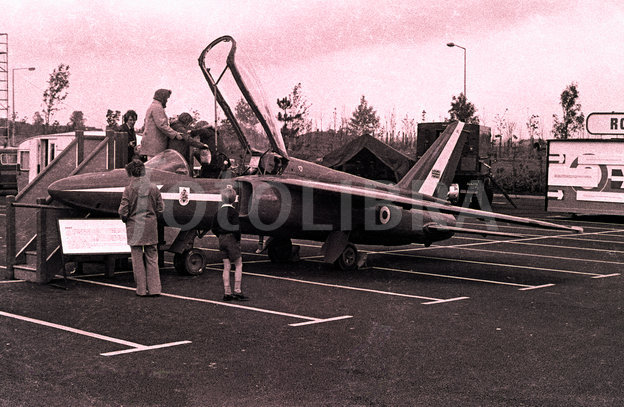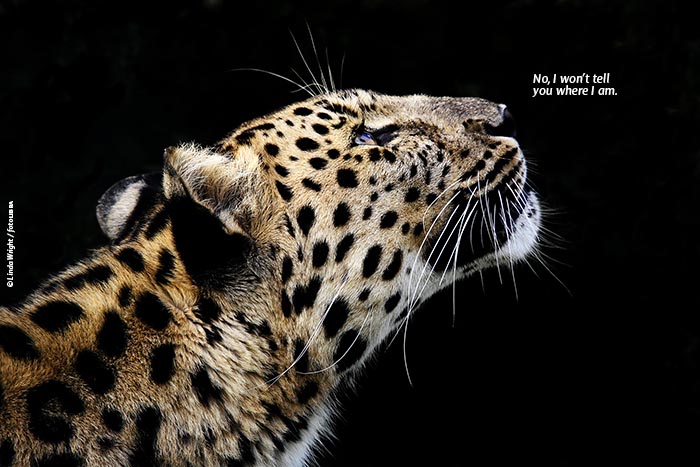Archive for the ‘Metadata’ Category
A Welsh Leaf
January 5th, 2016by Gwyn Headley
Managing Director
I was sent this wonderful image. I don’t know who sent it; the email address it purported to come from bounced back.
Through the magic of TinEye and PicScout I can probably track down the source, once I post it online.
But it’s not mine to post.
Whoever took the photograph should be proud. He or she has a good eye. I see a Welsh dragon in the shadow, which is why I’ve titled this ‘A Welsh Leaf’. (Everything looks like a nail to a hammer.) And the proud photographer probably added all sorts of information in the metadata, some automatically input by her DSLR or smartphone camera, some which she might have added to describe the image, caption it, keyword it, to help people to find it, buy it, share it, credit it.
But apart from its incomprehensible auto-created filename — 208655-1000-14471607882761860-R3L8T8D-1000-gjVfnT8.jpg — all the metadata you’d expect to be associated with this image has been stripped away. I don’t know who took this photograph, where, or when.
Why? Facebook, to name just one of the many social networks that automatically flail an image of its metadata (Google+ is the honorable exception), doesn’t deign to answer questions put to them, leaving users to speculate uselessly. The most popular theories aired online are
- To preserve users’ privacy
- To save space
- To lock people in
- To obtain licensing rights
Well we can discard #1 immediately, as acquiring your personal details is the whole purpose of a social network site — although it might have a scintilla of truth in that they’d be very reluctant to share anything with another social network, and if they left the EXIF and metadata intact then everyone could see it.
#2 makes a tiny bit of sense. Metadata can scarcely take up more than 1% of an image’s filesize, but these guys make their profits through nanopercentages. With 400 million images uploaded daily to Facebook, each say 50Kb, that’s 400 gigabytes they could save each day.
#3 Locking people in? They’ve got you by the short ‘n’ curlies already, but they might want to try and cement the relationship.
Which brings us to #4.
In Facebook’s Terms & Conditions, read by at least 1% of users, they assert that
“For content that is covered by intellectual property rights, like photos and videos (IP content), you specifically give us the following permission, subject to your privacy and application settings: you grant us a non-exclusive, transferable, sub-licensable, royalty-free, worldwide license (my bold) to use any IP content that you post on or in connection with Facebook (IP License). This IP License ends when you delete your IP content or your account unless your content has been shared with others, and they have not deleted it.”
What does this actually mean? It means they can do whatever they want with your images, and they can sell that right on to whomsoever they please. Money. Power.
It doesn’t matter that the image is lo-res at 72 ppi; they’re only interested in digital usages.
If you upload Jane Jones’s image under a Creative Commons licence to your Facebook page, and supply the appropriate credit, you are doing no wrong. But Facebook will strip the metadata and under the T&Cs you agreed to, you have granted them a non-exclusive, transferable, sub-licensable, royalty-free, worldwide license to use any intellectual property content that you post.
So who does Jane Jones sue? Certainly not Facebook. Even the government daren’t sue Facebook.
They ignore copyright laws with impunity. They ignore tax laws with impunity. Corporations such as this are striving to become supranational, to become greater than the law, more powerful than independent states.
And stripping the metadata is the broken pane of glass that allows them to get away with it. They’re taking the locks off your doors. It shouldn’t be allowed. It shouldn’t be possible.
A Happy New Year to you all.
What Nice People We All Are
March 25th, 2015Several readers of this blog quite justifiably complain that I moan too much.
I agree, and I apologise. It’s partly due to being a grumpy old man (it comes with the territory) and partly due to the appalling state of the picture buying market, with some users (or thieves, as we like to call them) feigning astonishment that pictures have to be paid for.
So to please you all (and me) here is a cheerful mystery with a happy ending (and I’ve added a link to another wonderful, heart-warming story at the end of this blog). I have always maintained that fotoLibra’s contributors, as well as being gifted, talented, artistic and creative, are a really pleasant bunch of people. It’s a joy to work with you all.
This was brought home to me again this week when prolific fotoLibra contributor Geoff France uploaded an historic image of a Folland Gnat (that’s an aircraft, for the benefit of Jacqui Norman). Here it is:
Our Aviation Guru, Colin Smedley, checks and edits all aviation images uploaded to fotoLibra and he queried the serial number of the plane. This is what he asked:
Can you get someone to look at the large image and tell me what the aircraft’s serial number is please? It is on the rear fuselage near the tailplane and looks like XS10?.
We looked, and looked, and looked, but could we see a number? No, we couldn’t. We told Colin:
We’ve downloaded this image of a Folland Gnat but can’t see a serial number near the tailplane.
He replied:
This has got to be the greatest fotoLibra mystery of all time! [well — a pardonable exaggeration …]
Fact: From the keywords we know the picture was taken in 1974 in Telford town centre where the Gnat was part of an RAF display.
Fact: We can see from the picture the display was in a car park.
Fact: The aircraft is painted in the colour scheme of “The Red Arrows”.
Fact: RAF Cosford is not far from Telford.
Fact: In 1973 a batch of redundant Gnats was delivered to RAF Cosford for instructional duties.
Fact: Some of these aircraft were in “The Red Arrows” paint scheme. It seems reasonable to assume from the evidence that the Gnat pictured was one of this batch.
Fact: Some of this batch delivered to RAF Cosford had serial numbers in the XR9?? and XS1?? ranges.
Fact: In the small image displayed on the fotoLibra image page there are what appear to be some digits on the side of the Gnat. These appear in the bottom of the vertical stroke of the letter R in the FotoLibra watermark. One of these digits looks to me to be an S or a 9.
Fact: In the large image you sent to me there is no trace of a serial number.
So in the RAF jargon of the time, WHIH? (pronounced WHee-ee? – What the Hell Is Happening?)
So we asked the photographer if he could help, and he replied:
Unfortunately I only have this photo and no other details than I put in the keywords. Cosford is the most likely source – Shawbury is the only other local RAF Base. There is a number on the side but magnifying does not help. There is also a badge just behind the air intake which seems fairly clear.
I can try to scan it again at a higher resolution. I could also email the original scan to you if you want to try putting it through Photoshop.
And then the answer came — from Colin:
I opened the big image in Photoshop, increased the contrast and transferred it to my special image enhancing software. Red Arrows Gnat serials were always difficult to make out in monochrome as they were painted in blue on the red basic colour. Anyway out of the morass of grain I could just make out what looked like “69”.
Eureka moment!
I went back to the complete image for another look and there were the clues I had missed before jumping off the screen at me. The Gnat’s nose appeared too short and there was no nose-tip landing light! This has to be a picture of XM693!!
XM693 was the first prototype Gnat T.1. It had a short nose because it was converted from an uncompleted single-seat F.1 airframe, It was never fitted with the nose light that equipped all production machines. After a brief flight test career, which included the 1960 SBAC Show (where I photographed it), it was given to RAF St Athan Boy Entrants School where it was used as an instructional airframe until 1968. It then went to the RAF Exhibition Flight who painted it in Red Arrows colours and dragged it around shows and fetes all over the country for the next ten years or so.
There we have it – the answer was under my nose all the time.
Now we have to find out what Colin’s special image enhancing software is, and why he’s keeping it to himself.
This is a wonderful example of the attention to metadata detail that characterises fotoLibra, and I don’t for a minute expect that anyone would get that level of care from a microstock agency.
It’s real exchanges like this with real people that make working at fotoLibra so enjoyable. If you have been with us a while you may remember this orchid exchange from some years back — and if you don’t, please read it; it is an absolute classic.
fotoLibra Obstructs Poachers
June 10th, 2014by Gwyn Headley
Managing Director
Many cameras and smartphones now come equipped with a GPS sensor which broadcasts the precise location of the device. A brilliantly conceived piece of work, and useful in all sorts of ways.
Except one.
If you use your GPS-enabled camera to shoot wildlife — you could be helping poachers to shoot wildlife.
All they have to do is check the EXIF data in your image and they’ll see the precise coördinates of the camera when the photograph was taken. Then they pitch up at the site, and shortly afterwards the last remaining black rhino will wander past. Bang.
At fotoLibra we don’t like this. So we’ve made the decision to strip the GPS data from every wildlife photograph in our library.
That’s 13,878 images which poachers won’t be able to use to track down and slaughter animals.
It’s a small step. But we hope other image collections will follow.
fotoLibra And Metadata
July 4th, 2013If you read my previous posting about the CEPIC Conference, where I was asked to deliver a speech on metadata 24 hours before having to give it, I threatened to post as much of it as I could remember on this blog. Well, here it is:
“Many of you may not have heard of fotoLibra. This is the first CEPIC conference we’ve attended. So to give you a little background, fotoLibra is 10 years old, we have 750,000 Rights-Managed and Royalty-Free images, 90% RM, 10% RF, of which 500,000 are unique to us. Despite our small size and our relative newness, we rank fourth among general rights-managed picture libraries in the UK in the number of website visitors we get.
Unlike the majority of people who start picture libraries, I’m not a photographer; I am just a man who takes photographs. I come from a book publishing background, and by inclination I’m an historian.
Of course six months after I became a picture librarian I knew it all, I knew everything, and I turned up at a BAPLA metadata meeting with the solution to everyone’s problems: DOIs — Digital Object Identifiers. DOIs are widely used in academic publishing, and the concept is hard to fault. One persistent identifier, one long number, would be embedded in the digital object so it could not be stripped out, like versions of Adobe Photoshop strip out embedded IPTC metadata, like Facebook and Twitter routinely strip metadata.
The joy was that the DOI wasn’t in itself the metadata, it was merely a pointer to where the metadata was stored. And this data could be enhanced and extended, so rights information could be added or revised and the DOI would always direct you to the latest data.
A friend of mine, Rob Wilson, was in charge of DOIs at HMSO, Her Majesty’s Stationery Office. He gave me 50,000 of them to get started with. He explained to me in great detail what they did and what they were all about, but I’ve never been able to understand a word Rob says.
After he left HMSO, the allocation of DOIs was taken over by another company. A bright-eyed (presumably) and bushy-tailed sales exec got in touch to say they would now be supplying fotoLibra with DOIs from now on. “The great news,” he enthused, “is that from now they’ll only cost you a dollar a year.”
That’s $1 per image. For 750,000 images. Every year. Persistently. For ever.
We no longer use DOIs.
Rob is now for the Application Developer for the PLUS Coalition.* Like the DOI, the PLUS identifier is a persistent embeddable string which refers to an external metadata source. To me it looks like the way forward for stock agencies and picture libraries.
A little anecdote about Rob: we were in South Wales and he had a meeting to go to, so he dropped me off at his parents’ house for an hour. They were a charming, elderly couple, and they made me tea and gave me a bun. After about ten minutes, Rob’s father leaned forward and asked me, “How long have you known Rob?”
“Oh, about ten years,” I answered.
“Tell me,” he said, “have you ever understood a word that he says?”
What was always of prime importance to me, wearing my historian’s hat, was the writing on the back of the photograph. How else do you know what’s in the picture, what it’s all about? That’s how I describe metadata to people who still don’t know the word; like a distinguished presenter I heard on BBC Radio 4’s Broadcasting House programme the other Sunday. He had only just come across the word metadata, and he was busily poo-poohing it. Clearly we have a long way to go in educating people.
I’m a member of a Facebook group (I hate it that Facebook knows I’m a fat git who likes rugby) on architectural follies. Some excellent photographs are posted to the group, and the other day I felt moved to ask if the people who uploaded them knew that Facebook stripped off the metadata and made them, by default, orphan works. I wrote:
“I hate to come across as Mr Kill-Joy, but I hope you know that Facebook deliberately strips all the metadata from images that are uploaded to it, rendering them as Orphan Works. In the UK, let alone the rest of the world, this effectively means that anyone will be free to use your images without any credit or payment. OK, this is a broad-brushed description, but it summarises the situation.”
In other words, under the blatantly unfair legislation the UK government has just passed, other people could freely use them. One replied:
“I’d rather share the photos than worry about the meagre profits potentially to be derived from them. (And as someone who writes on an unrelated subject, I’d say the biggest problem in this general field is people — and institutions — aggressively claiming rights to images that they don’t actually have any legal right of control over).”
Another responded: “My photos are not large enough / high enough resolution to be of interest to professional libraries (including fotoLibra) or photo editors so I put them up in the knowledge someone may “borrow” them in future and that’s fine it if spreads the knowledge and appreciation of follies. At the same time I know they are not professional standard enough to meet a photo editors’ requirements. Others may wish to take note though …”
Well, they don’t have to hide them away if some persistent identifier can let it be known that they hold the copyright. (And quality is relative — better to have one lo-res image of me shaking hands with Churchill and de Gaulle than none at all.) This is where Creative Commons is so powerful, over and above its original function — it introduces the concept of copyright, ownership and credit to people who are not necessarily bothered about remuneration.
There is in Britain a wonderful website called Geograph.org. Its simple plan is to create a photographic record of every grid square on the Ordnance Survey map. They’re doing the same thing for Germany. There are a few parts of Wales and the highlands of Scotland which remain uncovered, but in general wherever you go in the country there’ll be a photograph — perhaps several — of it on Geograph.
All the photographs are uploaded by members of the public. Some are iffy, some are just staggeringly beautiful — and they are all ‘licensed for reuse under the Creative Commons Licence.’
This is wonderful. The majority of people happily uploading their images to websites have no idea of the importance of rights, or the role that metadata plays. Geograph is educating people in the importance and relevance of metadata and rights.
So how does fotoLibra manage rights? Well, for us it really is a frictionless process, because we do it manually. We are still in the unhappy situation of being on first name terms with most of our customers, and we deal with them as individuals. Not for us the tiresome process of clearing rights on 15,000 images for MegaCorp, Inc., no no! A quarter page for Merionethshire Life and we’re well away.
It would be great to have experience in all aspects of the process, from being a photographer trying to sell his work and coming to the realisation that pressing the shutter is just the start of a very long workflow; from the agents like us presenting the work to buyers; to life as a picture buyer trying to get the right pictures together, with all the data and the clearances they need.
My Radio 4 man sneered at the construct ‘metadata’. He felt it was an unnecessary overcomplication. Metadata has been defined as ‘data about data’. I agree with him that it is human nature to complicate things as far as possible. On the motorways, ‘Your International Partner In Logistics Solutions’ actually just means ‘I’m A Truck’. Remember Occam’s Razor, and let’s keep it simple.
As Richard Bamford of Extensis pointed out in his speech earlier today, a lot of our confusion is down to left- and right-brain processes. Photographers tend to be visually orientated and words, metadata and organisation are less important to them.
fotoLibra is here to help.”
*Jeff Sedlik, the co-founder, President and CEO of the PLUS Coalition, was giving the speech after me. He began by saying, “I’d just like to point out that Rob Wilson, who was mentioned by the previous speaker, is indeed our Application Developer. And, for the record, we’ve never understood a word he says either.”
The Dictatorship of Social Media
March 14th, 2013by Gwyn Headley
Managing Director
This isn’t an anti-American, anti-government or anti-big business rant, it’s simply a plea for fairer play.
We continually stress the need for our photographers to add good and relevant keywords to their images, what we in the trade call the metadata. There are several reasons for this, and by far the most important to us is that without sensible, accurate keywords the most wonderful photograph in the world will never be found and therefore never sold.
The second most important reason is that once the picture sets off on its pilgrimage around the world it will be carrying with it its own passport or ID card, so that everyone who encounters it will know who it is and where it came from. If you have a home to go to you’ll never be an orphan.
Yet the British government is contemplating passing legislation on “orphan works” that could enable the use of a photographer’s intellectual property without prior permission and without a full and diligent search for the copyright holder. In “Digital Opportunity“, a report by Professor Ian Hargreaves, orphan works are defined as ‘works to which access is effectively barred because the copyright holder cannot be traced’.
No problem for our plucky little photographs. They’re armed with their passports and ID cards from the Fortunate Kingdom of Metadataland.
But what if, on their travels around the world, they venture into the Despotic Dictatorship of Facebookistan? Or the Democratic People’s Republic of Twitterbia? Or the Confederated States of Flickrania? Or any of the SocMed Pact empires?
Also no problem — for Facebookistan, Twitterbia and Flickrania, that is. They will automatically strip the photographs of their identity. The Fortunate Kingdom of Metadataland passport will be routinely removed and destroyed. Our photographs’ individuality will be erased. They are then free to carry on their journey without let or hindrance, but now descamisados; rootless, unidentifiable and orphaned.
This is what will happen if you upload a photograph to Facebook, Twitter or Flickr, as well as to Pictify, Photobucket and a host of other websites. Your metadata, your EXIF data and everything else that identifies the image will be discarded. It will become an Orphan Work.
Send a picture to the BBC after a winsome presenter pleads with you to upload your funniest animal photographs and you’ll find that suddenly the world’s cuddliest corporation will own your image outright in perpetuity without recompense.
Why?
Because they can, I guess. If you can steal, and the law permits you to get away with it, then it would be dumb not to steal.
According to a study by the International Press Telecommunications Council (IPTC), major social networks like Facebook, Twitter or Flickr remove copyright information and other useful embedded data from pictures posted by their users.
Some sites don’t automatically deprive images of their data. Google+ and Tumblr come away with less blood on their hands. fotoLibra even ADDS to your metadata, to make it safer still.
Remember the fuss in December when Instagram altered its terms & conditions so that on January 16th the one billion images uploaded to their site would become their absolute property, with no recompense to the photographers? The outcry was massive, and grudgingly they had to back down. But no apology was ever forthcoming and their lawyers were still screaming and spitting defiance and denying malfeasance after the deadline had been and gone.
Have a look at IPTC’s photo metadata test results for Social Media sites. I’m afraid they don’t surprise me one bit.
There must be some affordable way of embedding metadata in a digital image which would destroy that image if it were removed or tampered with.
It’ll have to wait for a better coder than me.
How Easy It Is To Strip Metadata
July 4th, 2012by Gwyn Headley
Managing Director
Here’s a great photograph by Gabor Poszgai that we sold to The Sun yesterday:
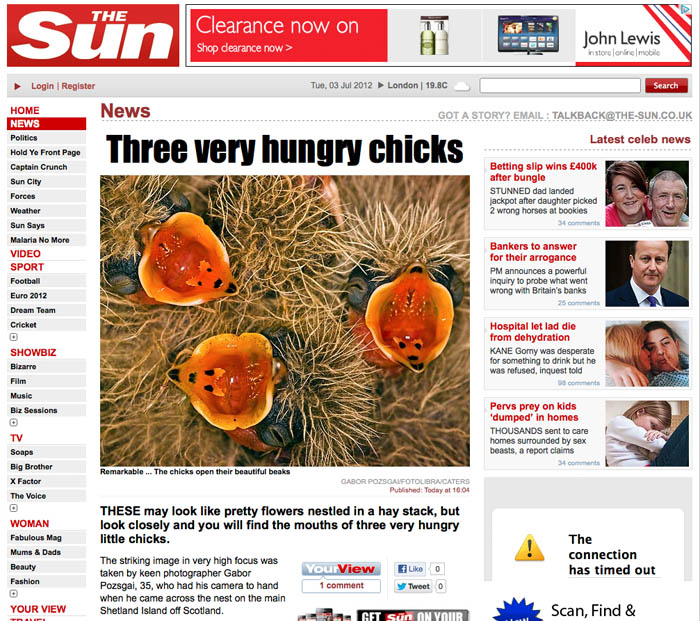
Purely as a matter of interest I tried to drag the image off the page. Obviously it had no fotoLibra watermark, as we had sold them the image, but I wanted to see how easy it would be to copy the image and use it for my own nefarious purposes — steal it, that is.
Here’s the message I got:
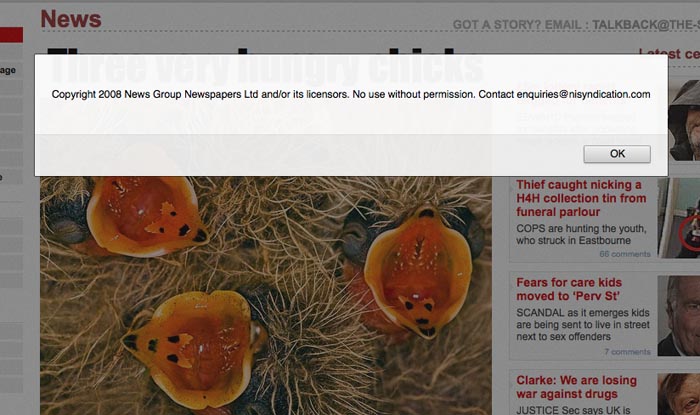
That’s interesting. I couldn’t drag the image off, and there was an image protection warning.
So I tried right-clicking it, a procedure incomprehensible to we Mac users but which involves holding down the ctrl key while tapping the pen on the tablet.
This is what came up:
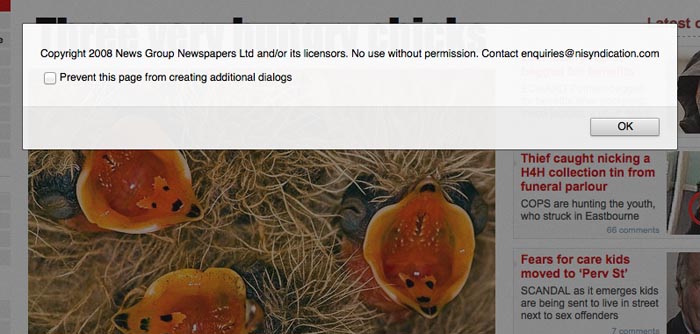
Gosh again. They really didn’t want me to pull off the photo.
So we pulled it off, and I had a look at the metadata.
When The Sun bought the image, it was supplied with full metadata including this caption and these keywords:
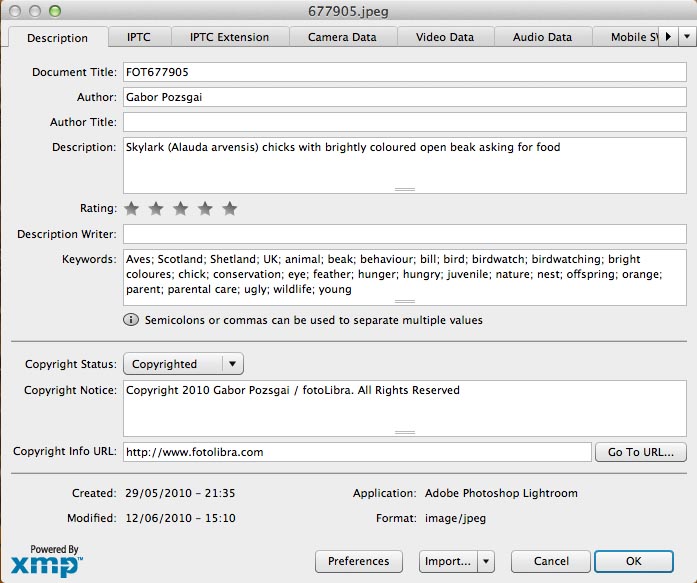
So you can see who took the picture, what it is, and where to find it. When I looked at the metadata for the image in The Sun, this is what I got:
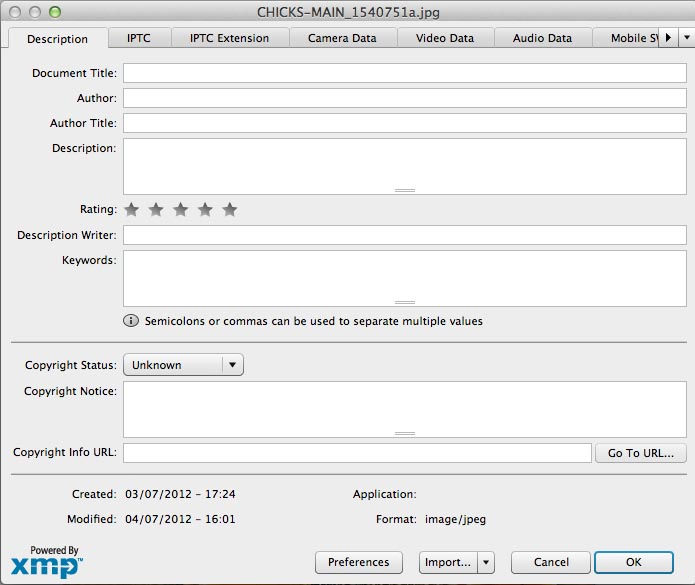
Empty. Blank. Nada. Bare. Stripped. Descamisados.
Why should they do that? Damien somewhat cynically remarked “Why keep it? They didn’t need it, so they threw it out.”
But that would mean extra work — someone would have to be specifically employed to hack off the metadata, unless it was an automated procedure. Why would News International want to remove the metadata from images they buy? Maybe Photoshop, with its inbuilt metadata stripping feature (see ‘Adobe — Stop Overcharging UK Customers‘) was to blame.
Anyway, I’m puzzled. What is the point of embedding metadata so it travels with the picture, telling you what it is, who took it and when, where it is, all about it, how to find it and buy it, if it’s simply thoughtlessly stripped out the first time it’s sold? It’s the writing on the back of the print. Why rub it out? What is the point? Who benefits?
Carrots, Tigers, Potatoes and Lions
June 11th, 2012by Gwyn Headley
Managing Director
Jacqui Norman has been berated by several members for shouting at them and generally being a Bad News Bear. She has been urged to display the sunnier side of her nature and I have persuaded her to take a leaf out of the American Business Book, so in future in her Newsletters she will be presenting everything as uniformly and unfailingly wonderful, great, successful, happy, excellent and perfect. Sadly it is not her nature (I have yet to see her sunny side) but she has promised she will try.
This leaves the coast clear for me to shout at you. Well, not you personally, obviously, because your fotoLibra input is perfect in every way, but a couple of your colleagues could brush their ideas up.
I’m talking about over-enthusiastic keywording. The only people who search the fotoLibra site daily and in great depth are Yvonne and me, preparing lightbox after lightbox for our clients. We need to find the correct images fast, and in fotoLibra we have built a wonderful system that enables us to do just that.
But we are dependent on the keywording skills of our photographers. We do realise that if you’re great in the chemistry classroom that talent may not transfer to the cricket field. And if you are gifted with a photographer’s eye you may not have the same facility with language. Yet words get your pictures seen. So they are absolutely crucial to the successful retrieval and possible sale of your images. We try to assist by providing you with a Typochecker so you can catch errors such as Hippopotmus instead of Hippopotamus.
What really, really irritates picture researchers like us are people who add irrelevant keywords to images in the hope that they will rise up the visibility rankings. Last week a customer wanted a picture of a radish. fotoLibra showed me a plate of dried mushrooms. The photographer had added potato parsnip radish tomato parsley mushroom swede turnip vegetable squash courgette zucchini marrow carrot and more to his keywords. None of the keywords, apart from mushroom, was visible in the image. That is plain wrong.
Yvonne needed a picture of a hippopotamus. She found a close-up photograph of the head and shoulders of a cheetah, along with these keywords: St Lucia; safaris; estuary; boat trip; excursion; travel; holiday; sightseeing; Kwazulu; wild life; hippo; crocodile; Nile; tourists; calendar; brochure; travel; holiday; adventure; bird life; fish eagle; Hippopotamus; Hippopotmus amphibius; seekoei; fischadler; aguila pescaddora; lowenbaby; cachorro de leon; leeuwelpie; elegant; elefant; olifant; gepard; guepardo; jagluipaard; nijlpaard; nilpferd; lion; leeu; lowen; leon; Panthera leo; predator; hunter; feline. In this photograph of a cheetah, the word “Cheetah” did not appear among the keywords. But Hippopotamus did, as did Lion, Crocodile and the German for Osprey.
Why? Why? Why? What possible help can it be to add Carrot to a picture of a Tiger? Or Lion to a picture of a Potato? When two or three examples of this excessive, inaccurate keywording crop up, we simply click a button and exclude that photographer’s images from that search. So they are damaging their own chances of making a sale. I am glad to say that out of tens of thousands of fotoLibra photographers, only a handful are spoiling it for the rest of you.
So please, please, please don’t do it.
And You Know Who You Are!
The most important part of a photograph
November 21st, 2011by Gwyn Headley
Managing Director
I know Jacqui Norman goes on and on at members about the importance of GOOD metadata, and I’m delighted that our aviation expert Colin Smedley has reinforced her call, albeit with a coruscating look at the current standards of categorisation and keywording to be found among fotoLibra photographers. He certainly hasn’t minced his words. Here’s Colin:
Over recent weeks I have been taking a careful look at thousands of images in the fotoLibra library, all categories, not just aviation, just to see what was on offer. You might be surprised at my opinions on what I found.
If you are taking a coffee at this time you might like to put it down in case you splutter all over your keyboard!
Just over 20% of images are in the wrong categories. This in itself is not too bad a problem but it is definitely a frustration amplification factor for picture researchers. Many photographers seem unable to determine the principal subject of their picture. For example a image of a large car with a tiny sticker in the windscreen does not really belong under “advertising”; but a close-up of the sticker may.
About 45% have titles that are inadequate, inaccurate, misleading or just plain wrong. About 15% have titles that are “arty-farty” to the point of being meaningless to researchers. Some even have instead of a title an alphanumeric reference that means nothing to me, researchers and, I suggest, fotoLibra.
About 75% have keywords that are woefully inadequate, misleading, totally wrong or even absent altogether.
About 25% have keywords not properly entered, for example with full stops, hyphens, colons and slashes instead of commas or semi-colons. [crucial separators — GH] Many have sentences or even paragraphs in the keywords box, that is to say keywords that really belong under “description”. Some have keywords and/or descriptions that are transposed and in some cases cut and pasted from other websites such as Wikipedia. Incidentally, have you noticed the increasing internet trend to call keywords “tags”? A very large number of authors are confused by the term “description” and supply a descriptive history of the subject instead of a description of the image.
The combined effect of these failings on sales is potentially enormous. Large numbers of images being invisible to buyers, researchers being put off because they are presented with images with no relevance to their input parameters and random browsers puzzled by finding traction engines under “birds” or birds under “transport/maritime”. None of these factors can be relied upon to impress potential buyers with fotoLibra’s professional attributes.
Sorry to rant on but I did feel my opinions and misgivings needed to be aired. However you may consider these views should be more widely read.
Thank you very much indeed, Colin. We most certainly do.
We’re all here to sell images. We are aware that visual talent is not always congruent with verbal description — we don’t expect surgeons to be boxers as well. But professional picture buyers need to know they’re dealing with professionals, and professional photographers make sure their images can be found by adding concise, accurate, relevant keywords to their metadata.
Incidentally few things irritate picture buyers more than irrelevant over-keywording. A photograph of a lion should not include a list of its prey and other creatures which might be found in a 100 mile radius. It’s a lion, not a warthog, wildebeeste, tiger or elephant.
Colin wants us to recruit an army of expert volunteers in several fields to undertake the work he has started with the Aviation category. That’s a high hope, because men like Colin are the exception rather than the rule, but it’s worth asking anyway.
If there’s a particular subject you feel passionate about, would you like to help vet fotoLibra images in that category? I do what I can for architecture, but I can’t tell a gazania from a geranium. Please let me know if you’re interested. Your endeavours will be rewarded with praise and publicity.
The Keyword Poem
January 29th, 2010by Gwyn Headley
Managing Director
I’ve lifted the following verbatim from Jacqui Norman’s regular newsletter to fotoLibra members.
“This strange poem, discovered on a fotoLibra server, lists in strict sequence the most commonly used keywords for the images in the fotoLibra archive. It’s more likely to have been on an Apple XServe than an HP Proliant, but all we know for sure is that this is the precise unedited and unaltered order of frequency of all keywords. Words appear individually; where they appear as if they could be linked, such as in
yellow
stone
east
africa
they’re not; that’s just the way the mop flops. Oh yes — and we inserted the punctuation and line breaks where we felt it to be right.
Of the water — England — and sea blue nature: UK!
White sky in park, travel, architecture: Britain!
Red landscape, river, beach, city tourism, north united, holiday trees.
A green south coast (formula Europe).
National great, grand black Wales.
London building garden, British west;
Flower, lake, old bird tourist art.
Summer kingdom, prix heritage, flowers tree to boat on wildlife people.
One Church — Scotland! Street winter history, new vacation bridge.
Mountains young, view wild, sand countryside, house (yellow stone) —
East Africa?
USA?
Clouds, snow, mountain, transport, country sport, car, animal island, town colour — Italy! Boats, sun …
America: light tower, road holidays, sunset world.
Castle: English man attraction portrait. Autumn birds, buildings spring, fishing; grass, air — life.
Animals rocks harbour, from up plant rock Spain food plants. Woman by colourful France at natural historic walking religion; village leisure leaves China bay forest seaside girl.
American sunny night (racing culture) ocean gardens — coastal brown — scenic day valley war with motor.
Ireland: ancient David beauty, wall orange.
Traditional beautiful wood female children, aircraft farm woodland royal field; pink color, hill high — reflection.
Sunday states steam evening is market for lifestyle. Close religious centre!
Head flying, canal weather, abstract ice coastline.
Cold railway district. Environment islands? Scene bright.
Horizontal rural Yorkshire; Canada; Asia; European child.
Stunning, isn’t it? Eat your heart out, Gerard Manley Hopkins. Can an Apple XServe be nominated for Poet Laureate?”
Talking about poetry, last year the local council in Gwynedd put on a series of Poetry Appreciation night classes, so along went Jacqui Norman. Only women showed up. Typical.
Jacqui had a word with the organizer, who this season announced the same course renamed as Advanced Poetry Appreciation. It’s now packed out with men.
Most Popular Searches
September 4th, 2009by Gwyn Headley
Managing Director
When new members join fotoLibra they occasionally ask us questions (prodding us to see if we’re mortal, I suppose). If they do ask, perhaps the most common is “What are people searching for?”
It’s easily answered, and it’s of no commercial use to them or us.
The answer is
1. Sex
2. Breasts
3. Tits
Need I go on?
A professional picture buyer doesn’t do repeated searches anyway, so it’s hard to analyse the information. Most of them simply tell us what they want and leave us to do the searching, which is why we keep rabbiting on to our members about the importance of key words.
When I saw a list of the most pirated ebooks this year I had a feeling I could guess what would be on it. I was not wrong.
These are the books that have been downloaded through BitTorrent between 100,000 and 250,000 times this year:
1. Kamasutra
2. Adobe Photoshop Secrets
3. The Complete Idiot’s Guide to Amazing Sex
4. The Lost Notebooks of Leonardo da Vinci
5. Solar House – A Guide for the Solar Designer
6. Before Pornography – Erotic Writing In Early Modern England
7. Twilight – Complete Series
8. How To Get Anyone To Say YES – The Science Of Influence
9. Nude Photography – The Art And The Craft
10. Fix It – How To Do All Those Little Repair Jobs Around The Home
Depressing, but not as depressing as I’d feared.


